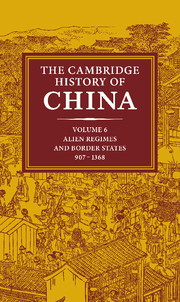Book contents
- Frontmatter
- Introduction
- 1 The Liao
- 2 The Hsi Hsia
- 3 The Chin dynasty
- 4 The rise of the Mongolian empire and Mongolian rule in north China
- 5 The reign of Khubilai khan
- 6 Mid-Yüan politics
- 7 Shun-ti and the end of Yüan rule in China
- 8 The Yüan government and society
- 9 Chinese society under Mongol rule, 1215–1368
- Bibliographical essays
- Bibliography
- Glossary-Index
- MAP 7. The Liao empire, ca. 1045
- MAP 12. The Hsi Hsia state, IIII
- Map 17. The Chin empire
- MAP 32. The Yüan empire">
- References
4 - The rise of the Mongolian empire and Mongolian rule in north China
Published online by Cambridge University Press: 28 March 2008
- Frontmatter
- Introduction
- 1 The Liao
- 2 The Hsi Hsia
- 3 The Chin dynasty
- 4 The rise of the Mongolian empire and Mongolian rule in north China
- 5 The reign of Khubilai khan
- 6 Mid-Yüan politics
- 7 Shun-ti and the end of Yüan rule in China
- 8 The Yüan government and society
- 9 Chinese society under Mongol rule, 1215–1368
- Bibliographical essays
- Bibliography
- Glossary-Index
- MAP 7. The Liao empire, ca. 1045
- MAP 12. The Hsi Hsia state, IIII
- Map 17. The Chin empire
- MAP 32. The Yüan empire">
- References
Summary
MONGOLIA AND TEMÜJIN, CA. 1150–1206
Tribal distribution
Toward the end of 1236 Mongolian armies under the direction of the great general Sübētei crossed the Volga in force, the right wing moving north into the Bulghar lands and the Russian principalities, and the left wing into the north Caucasus and the western Qipchaq steppe. By the time the campaign was called off in 1241, the princes of Russia had been subdued, and perhaps even more important from the Mongolian point of view, the numerous Qipchaq tribes, the last of the nomads of Eurasia to resist them, had been brought under their control. All of the “peoples of the felt tent” from Manchuria to Hungary were now members, through choice or compulsion, of a vast nomadic imperium.
The unparalleled unification of the steppe tribes under the aegis of the Mongols in the thirteenth century stands in sharp contrast with the division and discord of the twelfth century (see Map 24). The level of political and social integration in this period was most often the individual tribe or, at best small, unstable confederations of tribes. The strongest of these confederations, the Qipchaq in the west and the Khara Khitan in Jungaria, were able, it is true, to dominate sections of the steppe and its immediate hinterland, but they were nonetheless pale and imperfect imitations of the great nomadic empires of the past, such as those created by the Hsiung-nu, Türks, or Khazars. This lack of political unity was equally characteristic of the eastern end of the steppe.
Keywords
Information
- Type
- Chapter
- Information
- The Cambridge History of China , pp. 321 - 413Publisher: Cambridge University PressPrint publication year: 1994
References
Accessibility standard: Unknown
- 21
- Cited by
